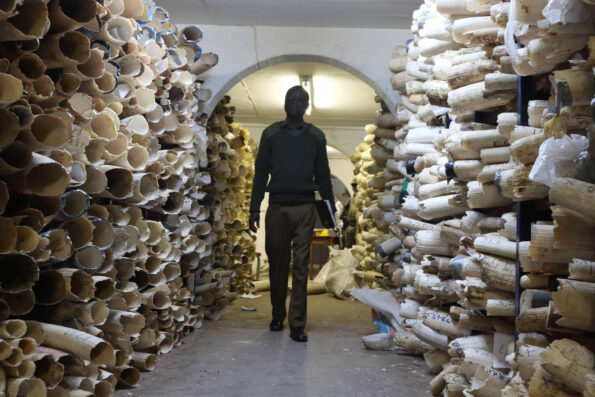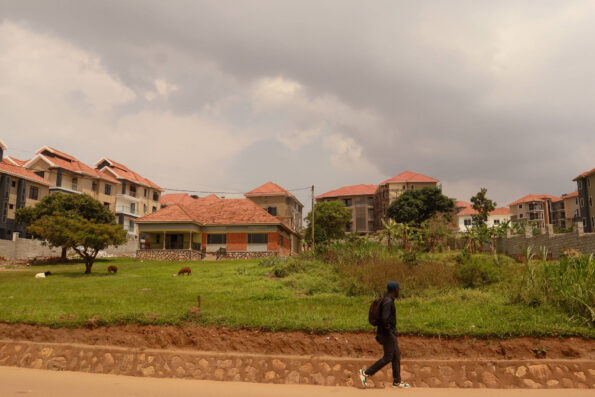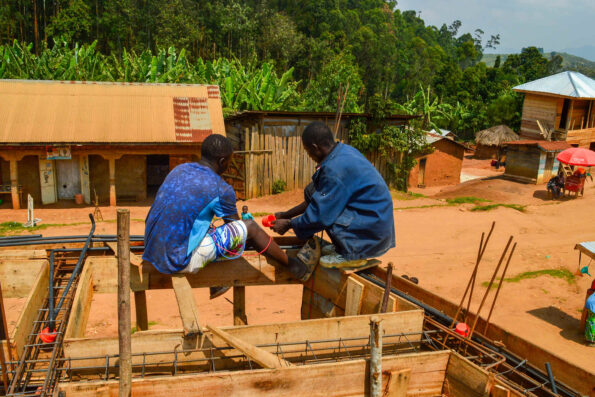
KATHMANDU, NEPAL – Even before official work hours commence at 9 a.m., people flood the Ministry of Foreign Affairs, police offices and embassies in Kathmandu, Nepal’s capital. Young people stand in long queues to obtain the various documentations necessary to leave the country, like passports and character certificates.
At the Ministry of Education, security personnel regulate a long queue of students. They are there to obtain No Objection Certificates, another document required for Nepali students who want to study abroad.
“This place is always crowded with people wanting to go abroad,” says Kamala Thapa, a security guard at the ministry.
Standing in the line of students is Seema Parajuli, 25, from Bharatpur, a city about 150 kilometers from the capital. Holding her certificates and other documents, a cheerful and energetic Parajuli has come to the capital so she could gather the necessary materials to apply for an Australian visa. She wants to pursue an undergraduate degree in nursing there.
“We wouldn’t [go] abroad if there were opportunities and employment in the country,” Parajuli says.
Parajuli says she belongs to a middle-class family. She works as a lab technician at Bharatpur College of Medical Sciences and has never faced the brunt of being unemployed. In some ways, she is luckier than many Nepalis.
But she says that she has been thinking of going abroad for the past few years because her husband and most of her friends have left the country.
“I want to say goodbye to Nepal soon,” she says.
It’s been a year since Parajuli’s husband left for Australia to study and work. Parajuli says she wants to join him and settle there.
The number of Nepalis leaving the country to study and work is on the rise as students and professionals cite a lack of opportunities at home. Sociologists and government officials say a lack of stability and employment in Nepal is responsible for this growing number. Some Nepalis worry about the negative effect that this trend has on the country, pointing out the “brain drain,” money invested elsewhere and lack of care for aging family members. But others say that remittances received from abroad boost the economy and people have the right in a globalized world to live where they want. Government policies focus on developing the nation’s youth, but even government officials say they haven’t implemented them sufficiently enough to combat the growing brain drain.
Roughly 1,200 Nepalis leave the country every day in search of more opportunities abroad, according to the Department of Foreign Employment. The majority of the some 440,000 Nepalis leaving the country every year are young. Yubaraj Paudel, undersecretary of the youth program section at the Ministry of Youth and Sports, estimates that 300,000 youth leave Nepal every year to study and work abroad.
In 2011, students obtained certificates to go to 64 countries, including the United Kingdom, Australia, the United States and Japan, says Laxman Kumar Khadka, undersecretary of the Department of Scholarship at the Ministry of Education. In the month of January 2012 alone, 815 students obtained their No Objection Certificates to study abroad.
“Every day the number of students wanting to go abroad keeps rising,” he says.
Many even stay abroad.
“Some of the students who take this NOC return, but most of them stay back,” Khadka says.
Other Nepalis migrate for work.
Nepal was among the 10 low-income countries with the highest migration rates in 2010, according to the second edition of the World Bank’s Migration and Remittances Fact Book 2011. About 982,000 Nepalis emigrated from the country in 2010. This constitutes 3.3 percent of Nepal’s total population.
Paudel says the number is even higher because the report doesn’t account for the millions of Nepalis who immigrate to India for work purposes or leave illegally.
Like Parajuli, Dr. Kalyan Bikram Shah, 27, is another young Nepali aspiring to go abroad. A native of Janakpur, a city southeast of Kathmandu, he spends hours at Internet cafes researching opportunities and frequently visits study abroad counseling centers.
“I want to go abroad for a good job and a secured future,” he says.
His family sold their land and took out loans to send him to medical school in China. But despite looking for jobs in various hospitals and nursing homes, Shah hasn’t been able to find one that suits him in terms of job description and pay.
“I’m becoming frustrated,” he says.
He currently works at a private hospital here and earns 25,000 rupees ($300) per month, which he says isn’t enough to pay the rent and feed his family. It also isn’t enough to pay the interest on the 3 million rupees ($37,000) that his family took out in loans for his education.
He says he has no other option but to go abroad, though he is aware of the poor health situation of the people in remote parts of the country and his responsibility to them as a doctor. He spent a few months working in Gulmi district to serve this population, as he says he dreamed of becoming a doctor so he could serve his country. But with the increasing cost of raising a family and paying back interest on his loans, he says he can't stay in Nepal and help the needy.
“There aren’t any good opportunities here,” he says. “The important moments of my life are being wasted here. I don’t want that to happen.”
The United States is his first destination of choice. But if can’t obtain a U.S. visa, he says he’ll try to go to a European country – or any developed country.
Ishwor Wagle, 39, is standing outside the U.S. Embassy in Kathmandu to obtain his visa. But his situation is different than Parajuli’s and Shah’s.
His wife won a Diversity Visa to the United States, also know as the Green Card Lottery, making migration easier for him. Mandated by the U.S. Congress, the Diversity Immigrant Visa Program is a lottery program that awards 55,000 visas annually to people in countries determined to have low immigration rates.
Thousands of Nepalis try their luck for this visa annually. Standing cheerfully, the lucky Wagle says he is ready to move to the United States.
“I want to embark to my dream destination as soon as possible,” he says.
Wagle and his wife are teachers at local schools and have two children.
Wagle is also active in politics and is affiliated with the Nepali Congress party. When he initially entered politics, Wagle thought he could end poverty, unemployment and corruption here. But he says that his sole effort couldn’t do much.
He also says that there is not much opportunity to advance as he comes from a middle-class family outside the capital. As frustration mounted, he and his wife applied for Diversity Visas last year.
“People like me don’t get respected here,” he says. “Now I’ll go to America and have a good future for me and my children.”
Kiran Acharya, who has been a professor of sociology for 15 years at Kathmandu’s Tri-Chandra College, cites political instability, lack of unemployment and an insecure future as the major reasons for migration.
“The middle class, skilled and educated, are migrating at a higher rate,” Acharya says.
Nepalis in the lower to middle class migrate as well. Acharya says they hope to earn a better income so that they can support their families, secure better education for their children, attain quality health services and pay back loans. They hope to save enough to eventually return to Nepal and and buy houses in their districts’ headquarters.
The educated and skilled workforce, such as doctors, engineers, nurses, accountants, Internet technology professionals, and even high-ranking officers from the army and police, leave for countries like the United States, Canada, Japan and European countries, Paudel says. The less skilled and uneducated Nepalis head to the Gulf countries.
The recent demand in developed countries for an increased workforce to assist in their industrial production has also increased the trend of people going abroad, Acharya says.
The Ministry of Education’s rule that lets doctors who studied on scholarships avoid the mandatory two-year work tenure in their country after graduating by paying 210,000 rupees ($2,600) has made it easier for doctors to go abroad, Paudel says.
As for engineers, they go to foreign lands because development has stalled in Nepal. Most of them make their way to Saudi Arabia and Dubai, lured by the 100,000 to 150,000 rupees ($1,200 to $2,500) they can earn there monthly.
The growing number of consultancies that help send skilled manpower and students abroad has also encouraged this trend.
Pawan Lamichhane, proprietor of ADA Consultancy, an organization that provides visa-related services, has been analyzing migration trends for years. He says it has become “glamorous” to go to the United States, the United Kingdom, Australia and Canada.
Narayan Krishna Shrestha, an undersecretary at the Ministry of Education, says that foreign countries offer higher salaries and facilities such as social security. Political instability in Nepal and a lack of development following a decade-long civil war, which ended in 2006, has fueled migration too. Also, Shrestha says that the state hasn’t been able to recognize and respect its people’s talent.
“To be honest, in today’s context, even professionals want to migrate,” he says.
Shrestha says that the country suffers when talent, or skilled workers, migrate. Students also take with them the revenue that they would have spent in the country.
Surendra Kharel, chairman of Authentic International Education Services Pvt. Ltd., a company that provides consulting services to students and professionals looking to go to Japan, says people could use their savings to establish their lives here.
“With the money one spends on going abroad, they can do something here,” Kharel says.
People who migrate often blame the government and political leaders for not doing the right things, Kharel says. But it doesn’t make sense running away from the problems and going abroad to make more money.
“Instead of blaming others, you should do something,” Kharel says.
Others say it’s not just money that the country loses with the rising rates of migration.
Srijana Sharma, 66, of Kathmandu says she thought that she had educated her children enough to launch successful lives here. But instead, they migrated.
Though Sharma’s son sends her money, she says that care and love are more important at her age. She lives alone and says she has no one to take care of her.
Sharma has visited her son and daughter in the United States, but says she hasn’t been able to spend more than a month in the foreign land because she is left in a community that doesn’t speak her language while her children and grandchildren are off at work and school.
“My son and daughter-in-law don’t want to return,” she says. “And old people like us want to die in our own country.”
Though she lives alone, she says that she’s not alone in her predicament.
“It’s not only my problem,” she says. “It’s every other household’s problem.”
Mohan Sharma, an active member of the Nepali Congress Party in the Morang district, says that as more youth migrate to foreign lands, most villages are filled only with the elderly. He says that by age 18, people tend to have lost hope in the country.
“It’s not only in the cities,” he says, worried. “Even in the villages, people are giving up hope on the country.”
But Khadka says that going abroad helps Nepalis hone their skills and receive quality education. He says that Nepal also benefits from the remittances it receives from citizens who go abroad. Among low-income countries, Nepal received the second highest remittance in 2010, according to the World Bank's Migration and Remittances Fact Book.
“If we don’t send them abroad and keep them in the country, their frustration could mount into other problems,” he says.
Khadka further points out that since the world has become “glocal” and Nepal is signatory to the World Trade Organization’s Global Village, people shouldn’t be restricted from living where they want.
“It’s their personal preference and choice,” he says. “They’ll go wherever they think it’s safe and better for them to live.”
The Ministry of Youth and Sports’ National Youth Policy 2010 aims to develop young people's skills and create an environment in which they can succeed at home. Recognizing them as valuable assets and agents of change, the policy regards them as a major source for economic, social, political and cultural progression in terms of nation building.
But even Paudel says that the policy doesn’t address the issues of security, employment, education and health significantly.
“We only implement programs as far as our budget goes,” he says.
Shah says that until the state provides strong employment opportunities and social security, going abroad will be the only option.
“If the country realizes our needs, we can come back in future,” Shah says.
But for Wagle, it’s a different story.
“I’m moving to the U.S. with my family,” he says. “I’m not obligated to return.”







